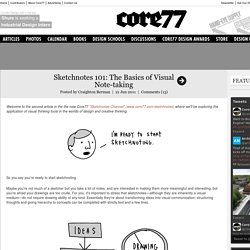

Sketchnoting. Mind Map. Visual Note Taking - NEXT.cc. Visual note taking is doodling with a purpose!

It keeps you busy, awake, alert and with a few suggestions, attentive! Did you know you develop listening skills, organizing skills and synopsis skills by being a visual note taker? Amaze your friends (and teacher!) By actively taking notes during a talk, a film, or a presentation. To get started you need your journal (or blank paper), a few sharpened pencils, and possibly colored pencils or markers. Be a visual note taker! Activity 1 Practice Visual Note Strategies Bullets are simple shapes that create categories and sub categories. Activity 2 Try your new Visual Note Taking Skills Listen to a presentation by your teacher. View This Activity's Gallery Activity 3 Practice Practice Practice!
In your journal start taking visual notes of as many things as you can. Review Bullets can only be lozenge shaped. Explore Back to Top Relate. Notetaking for Visual Learners (and Everyone Else) Someone else’s notebook usually leaves me B-O-R-E-D, but the ReadWriteWeb post on Mike Rohde‘s notes from South by Southwest Interactive has me glued to the screen.

I want to read every image (and fortunately you can see them one-by-one on Flickr). I’ve considered printing them all out so I can add my own annotations. If I were a better Delicious tagger, I’d add them all and mark them up so I could find them later. Why am I so entertained by scans of a plain, old-fashioned notebook? Some of the notes make me giggle. Other notes impress me with how well they capture what appear to be the key events and comments at different SxSW presentations. More than anything though, it’s that the notebook is so real and honest. How would you use these great notes in the classroom? And that’s not all. Finally, you might encourage students to recast notes from a recent class they’ve attended into a format similar to one of the pages in Rohde’s notebook. The Magic of Graphic Recording: Turning Live Talks into Visual Content. Source: Kelly@kingmanink.com; Click for larger view The magic of Kelly Kingman’s visual content creation work takes place over a couple of days.

But there’s nothing ephemeral about the impact it has on its audience. Kelly is a graphic recorder. She captures the main ideas from expert presentations delivered at live events, and turns them into memorable and eye-catching visual summaries on the fly. Her work was a hit at this year’s Content Marketing World, where she transcribed presentations from speakers like Jay Baer, Coca-Cola’s Jonathan Mildenhall, and Buddy Scalera on a big whiteboard next to each stage. After seeing the quality of her work, it’s hard to believe she’s only been at it professionally for about 18 months. “I’d been doodling pictures as part of my notes for a long time. Kelly was working as a content marketing consultant, when she got the opportunity to join a preeminent Brooklyn-based, a graphic recording company that works with Fortune 500 brands.
Share your experience. Sketchnotes 101: The Basics of Visual Note-taking. Welcome to the second article in the the new Core77 "Sketchnotes Channel" (www.core77.com/sketchnotes) where we'll be exploring the application of visual thinking tools in the worlds of design and creative thinking.

So you say you're ready to start sketchnoting. Maybe you're not much of a sketcher but you take a lot of notes, and are interested in making them more meaningful and interesting, but you're afraid your drawings are too crude. For you, it's important to stress that sketchnotes—although they are inherently a visual medium—do not require drawing ability of any kind. Essentially they're about transforming ideas into visual communication; structuring thoughts and giving hierarchy to concepts can be completed with strictly text and a few lines. Maybe you're perpetually drawing and want to try and make your notes more useful and engaging but you are afraid of imposing structure to your normally freeform way of sketching.
In the end, it's up to you. So let's get tactical.